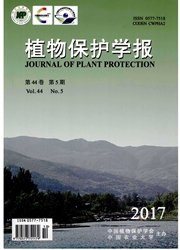

 中文摘要:
中文摘要:
为了从分子水平上揭示苹果树腐烂病菌的群体遗传多样性,采用正交设计对ISSR-PCR体系进行了4因素3水平的筛选,并从47条ISSR引物中筛选出11条多态性较好的引物。对供试的87个分离株进行扩增的结果显示,11条引物在129个位点扩增出稳定的条带,其中多态性位点119个,多态性位点率为92.25%。POPGENE分析显示,病菌种群的遗传多样性和基因多态性丰富,群体间的遗传分化系数(Gst)为0.109,群体内为0.891,群体内多样性大于群体间多样性。两个地理种群间的居群每代迁移数(Nm)为2.046,两者之间存在广泛的基因交流。在遗传相似系数为0.88时,可将21个自然种群划分为9个不同的类群,表明陕西省苹果树腐烂病菌的各个自然种群之间的遗传亲缘关系与其地理来源之间无明显的相关性。
 英文摘要:
英文摘要:
In order to detect the population genetic diversity of apple valsa canker pathogen(Valsa mali) at the molecular level,the orthogonal designed experiments were employed to screen the optimal inter-simple sequence repeat(ISSR) amplification protocol at three levels of four factors.Eleven ISSR primers which can amplify more polymorphic loci were screened from 47 ISSR primers.Eighty seven isolates of V.mali isolated from Shaanxi Province were studied for the genetic diversity.The results showed that 129 loci were detected of which 119 loci were polymorphic,the polymorphic loci percentage was 92.25%.The POPGENE analysis results showed that the genetic diversity of V.mali groups in Shaanxi was abundant,the coefficient of population genetic differentiation(Gst) among geographical groups was 0.109,while it reached 0.891 within the populations.The genetic diversity within the populations was much more abundant than among the groups.The number of migrants per generation between two geographical groups was 2.046,which indicated that genetic information exchange was frequent between the two groups.The dendrogram based on ISSR markers revealed that the 21 natural populations were clustered into 9 clusters at the threshold of genetic similar coefficient 0.88.There was no significant correlation between the genetic relationships and their geographical originals.
 同期刊论文项目
同期刊论文项目
 同项目期刊论文
同项目期刊论文
 Histological and cytological investigations of the infection and colonization of apple bark by Valsa
Histological and cytological investigations of the infection and colonization of apple bark by Valsa Genome sequence of Valsa canker pathogens uncovers a potential adaptation of colonization of woody b
Genome sequence of Valsa canker pathogens uncovers a potential adaptation of colonization of woody b Agrobacterium tumefaciens-mediated transformation of the causative agent of Valsa canker of apple tr
Agrobacterium tumefaciens-mediated transformation of the causative agent of Valsa canker of apple tr 期刊信息
期刊信息
